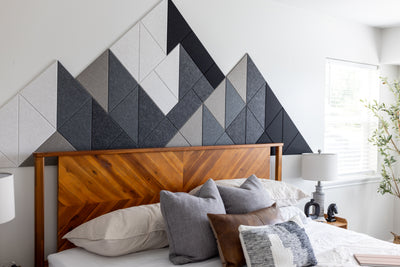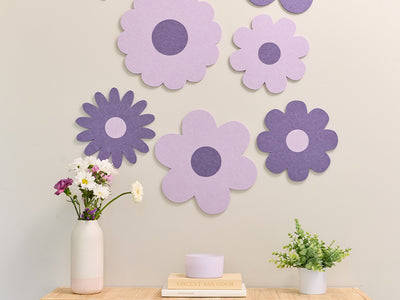Felt Acoustic Tiles vs Soundproofing Foam
Felt acoustic tiles and soundproofing foam are two popular options, but they serve different purposes and offer distinct advantages.
In this blog, we'll explore the differences between these materials, why felt acoustic tiles are the superior choice, and additional insights into their maintenance, durability, and cost-effectiveness.

What's the Difference Between Acoustic Panels and Soundproofing Foam?
Acoustic panels and soundproofing foam each play unique roles in sound management. Acoustic panels, like the felt tiles from Felt Right, are designed to improve sound quality within a room. They absorb sound waves, reducing echo and reverberation, which helps to clarify audio and enhance the listening experience. These panels are ideal for spaces where sound quality is essential, such as recording studios, home theaters, and offices.
In contrast, soundproofing foam primarily aims to prevent sound from entering or leaving a room. While it also has some sound-absorbing properties, its main function is to block sound transmission. This type of foam is commonly used in settings where it's crucial to keep noise contained or to prevent external noise from disrupting an environment, such as in music practice rooms or homes located in noisy neighborhoods.

Which is Better and Why?
Enhanced Aesthetics and Customization
Felt acoustic tiles from Felt Right offer a significant advantage in terms of aesthetics and customization. These tiles come in various colors and designs, allowing you to create visually appealing patterns on your walls. This makes them not only functional but also a decorative element that can enhance the overall look of your space. In contrast, soundproofing foam often comes in basic colors and blocky shapes, which might not blend well with your interior design.
Superior Sound Quality
When it comes to making your room sound great, felt acoustic tiles can be a great choice because they are fantastic at absorbing mid to high-frequency sounds — these are the main frequencies in human speech and music. This helps to reduce echoes and reverberation, making conversations clearer and music more enjoyable. The dense material of felt tiles, with its tightly packed fibers, traps sound waves effectively, stopping them from bouncing around the room. On the other hand, soundproofing foam is mainly designed to block sound and doesn’t fine-tune room acoustics as precisely.
Felt acoustic tiles also bring a lot to the table in terms of style. They come in various colors and designs, adding a visual boost to your space while improving sound quality. Plus, many of these tiles are made from recycled materials, making them an eco-friendly choice. Their ability to improve speech clarity makes them perfect for places like offices, conference rooms, and classrooms. With all these benefits, felt acoustic tiles clearly offer a better overall solution than traditional soundproofing foam.
Environmental Impact
Another compelling reason to choose felt acoustic tiles is their environmental friendliness. Felt Right tiles are often made from recycled materials, making them a more sustainable choice. Additionally, they can be easily moved and reinstalled, which adds to their longevity and reduces waste. Soundproofing foam, on the other hand, is usually made from synthetic materials that are less eco-friendly and harder to recycle, contributing more to environmental pollution.
Versatility and Ease of Installation
Felt acoustic tiles are versatile and easy to install, allowing you to quickly enhance your space without the need for professional assistance. They can be mounted using simple adhesive strips, making it a straightforward DIY project. This ease of installation means you can experiment with different layouts and designs without much hassle. In comparison, soundproofing foam often requires more effort to install correctly, especially if you aim to achieve significant soundproofing results, which might involve sealing gaps and ensuring proper coverage.

Maintenance and Durability
Easy Maintenance
Felt acoustic tiles are incredibly low-maintenance, making them a convenient choice for busy households and workplaces. To keep them looking fresh, a simple vacuuming or light dusting is usually all that’s needed. If a deeper cleaning is required, a damp cloth can be used to gently wipe the surface without damaging the material. Unlike soundproofing foam, which can degrade and crumble over time, felt tiles maintain their appearance and functionality with minimal effort.
Longevity and Wear Resistance
Durability is another area where felt acoustic tiles shine. These tiles are designed to withstand the test of time, maintaining their shape and effectiveness even in high-traffic areas. The robust material resists wear and tear, ensuring that your investment lasts for years. In contrast, soundproofing foam can easily get damaged, lose its shape, and become less effective at absorbing sound over time. Felt tiles' resilience makes them a superior choice for environments where long-term performance is essential.

Cost-Benefit Analysis
Initial Investment
At first glance, felt acoustic tiles might appear to be more expensive than soundproofing foam. However, this initial cost is offset by their superior performance and durability. The aesthetic appeal and customizable nature of felt tiles can also add value to your space, making it more attractive and functional.
Long-Term Savings
When considering the long-term benefits, felt acoustic tiles often prove to be more cost-effective. Their durability means fewer replacements and repairs over time, saving you money in the long run. Additionally, the improved sound quality they offer can reduce the need for additional soundproofing measures, further cutting down on costs.
Enhanced Value
Investing in felt acoustic tiles can also enhance the overall value of your property. Spaces with good acoustics and attractive design elements are more appealing, whether you're using the space personally or planning to sell or lease it in the future. This added value can make felt tiles a smart financial decision beyond their immediate functional benefits.

Treat Your Space for Sound With Felt Right Acoustic Tiles
While both felt acoustic tiles and soundproofing foam have their uses, felt acoustic tiles from Felt Right offer better sound quality, aesthetic appeal, environmental benefits, and ease of installation. They provide a more holistic solution for creating a pleasant and acoustically optimized environment, making them a superior choice for most applications. So, if you're looking to improve the acoustics of your space while adding a touch of style, felt acoustic tiles are the way to go. Shop our selection of felt acoustic tiles today.








